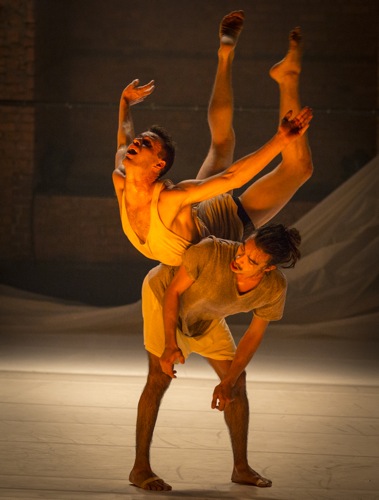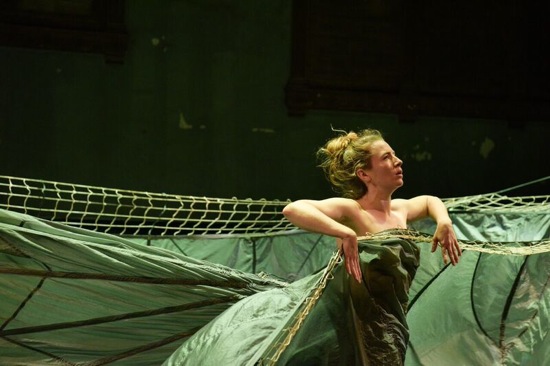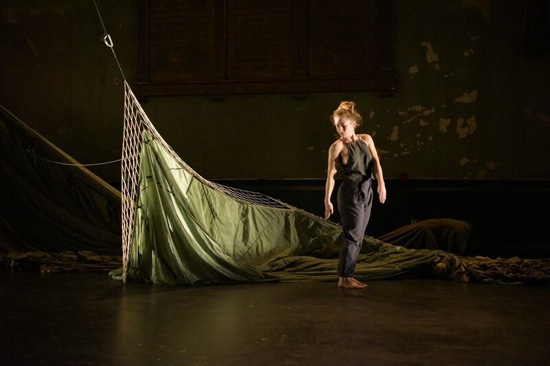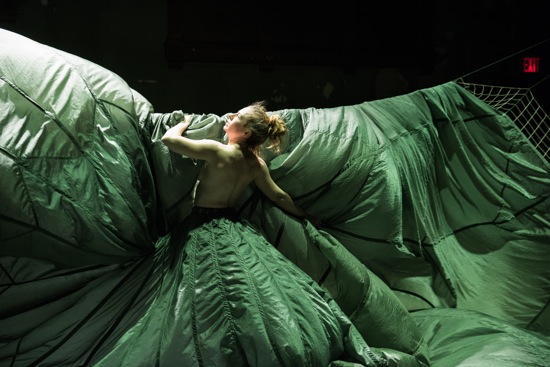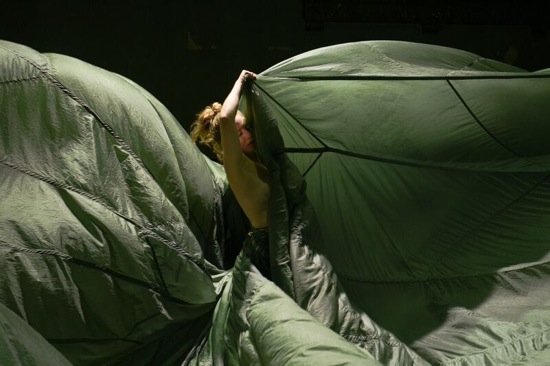Andrea Miller’s Gallim Dance at the Joyce 12/3-6; Anneke Hansen Dance at the Irondale Center, 12/2-5.
Andrea Miller’s powerful dances always make me think of tribes pursuing their goals, whether spiritual or practical. What lies behind that fiercely arduous, sometimes bizarre way of life may remain mysterious. Take a passage from her momentous new Whale. Six of her eight marvelous dancers are moving around the Joyce Theater’s stage as if it were a playground and they’re not sure what they want to do next. Daniel Staaf starts running rapidly around with Austin Tyson, every now and then picking Tyson up and employing him as a human weapon with which to knock the various of the others down with his feet. The two men never stop to see the results of their actions. The victims rise apparently unhurt, but the violence of the attacks is terrifying.
Miller is a mother with very young children, and writes in a program note that “whale” is a word her two-year-old sings out in the middle of the night, pointing into the darkness. She says it’s “as if one of those endangered mammals he loves lives in our apartment.”
Love itself can be a huge shape looming in a nighttime sea, sensed, welcomed, feared. Watching her whole-hearted, risk-all dancers, I see them as children—certainly not pretending to be children, but taking on some of the awkwardness, the faltering first steps, the wildness, and the repetitive actions with which children teach themselves about the world. When Whale begins, they’re all lying supine, legs spread, feet to the audience, sporadically standing up and dropping down again. They sing raggedly. not in perfect synchrony. Tyson asks a spectator in the front row her name, and they intermittently yell it (“Caroline!”) while flinging themselves around.
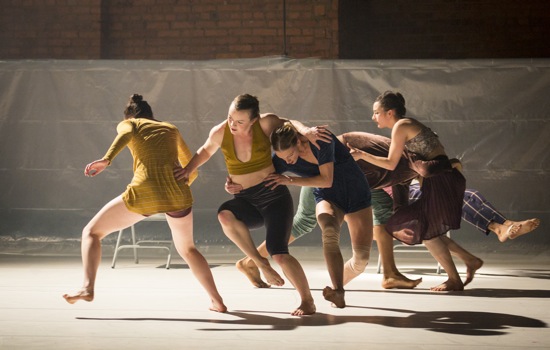
Andrea Miller’s Whale. (L to R): Gwyn Mackenzie, Allysen Hooks, Celine D’Hont, Georgia Usborne, Matthew Perez (half hidden), Daniel Staaf (leg only). Photo: Yi-Chun Wu
Games are a form of test. Staaf becomes the one that everyone wants to connect with. A person grabs one of his hands and twists and yanks and kicks within that grasp, doing his/her thing; swiftly another grabs Staaf’s free hand, displacing the first comer. Others race in to take a turn and then retreat to the folding chairs lined up along the sides and back of the stage. By the time the sound score being produced electronically by composer Jordan Chiolis and drummer Robert Natale has fallen silent, Gwyn Mackenzie is humping one of Staaf’s legs.
Left alone, Mackenzie explores movement possibilities—balancing on one leg in Nicole Pearce’s suddenly smoky white light, walking on rubbery legs that are apt to fold under her, leaping up and ending in a squat. The irony is sharp: these dancers who can do anything perform virtuosic actions that make them appear not fully in control of their bodies. When Matthew Perez and Georgia Usborne and come together, there’s a point at which she crawls along, with his neck caught in the crook of one of her knees. Tyson, on the floor, balances on the top of his head and one pointed kneecap.
In this world, people don’t always get what they want. Staaf approaches a person on a chair and lies supine at his or her feet—his head and shoulders off the floor, his arms spread, the palms of his hands facing up. The person doesn’t respond; neither do any of the others he runs to. Yet when he finally collapses face down, he becomes the base for a pile-up of the others that keeps resolving magically into a chain along the floor and then building into a stack again.
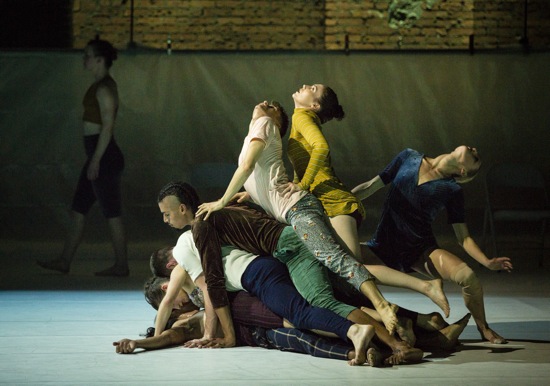
Gallim Dance in Whale. (L to R): Daniel Staaf, Georgia Usborne, Austin Tyson, Matthew Perez, Paul Vickers, Gwyn Mackenzie, Celine D’Hont; at back, Allysen Hooks. Photo: Yi-Chun Wu
It’s as if we’ve entered a long day in which strenuous activity peaks, then calms down or shifts. The music adapts to or announces the changes; Pearce’s lighting turns the stage bright colors, the plain, half-down backcloth rises. Patterns streak across the floor and disappear. In a scene just before the intermission that the dancers surely need, a sheet of semi-transparent plastic becomes a long skirt and then a place under which to hide or transform. From it, Paul Vickers emerges stripped of all his clothing into a scene that Miller handles with immense skill and sensitivity. You can see Tyson, Usborne, and Allysen Hooks as a family. When they cluster, Vickers nuzzles against them, seeking entry. Once he works his way into their midst, they fall back. But everything that they then do with this new arrival is unusual, clumsy in its solicitude. Miller avoids every expected cliché. The three rock this vulnerable person in unexpected, unsentimental ways. When Tyson helps him crawl, it’s like watching a man trying to keep up with and steer a giant speeding lizard.
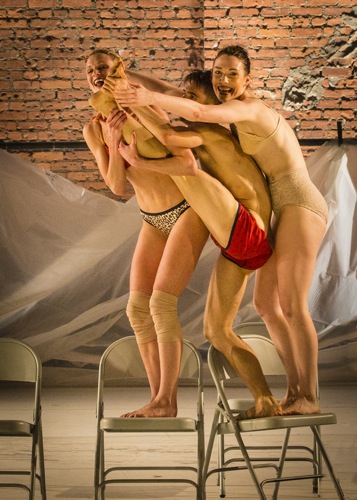
A moment in Andrea Miller’s Whale. (L to R): Céline D’Hont, Paul Vickers, and Gwyn Mackenzie. Photo: Yi-Chun Wu
As the piece progresses, we get ample glimpses of these remarkable performers. A peculiar kind of tag in which soloists drop out of a running herd gives us a closer look at them They encounter each other, as do Perez and Céline D’Hont, in brief duets. In one close engagement, Usborne carefully inserts her legs into the baggy shorts that Staaf is wearing and slips her head and arms into his shirt with him (when the others pluck her free of this soothing embrace, she ends up with the shirt, he with the pants. There are a few moments in this second half when the choreography seems less fine-grained than in the first half, less alert to possible shadings, But that’s a minor point in a marvelously daring work.Whale ends in an explosion of elation: Tyson skidding naked in water he has poured onstage, everyone flinging aside garments and yelling. Is the whale listening? Or is it dancing inside these wild-bodied revelers’ skins?
How do we perceive time in a dance? A ten-minute piece can seem to last a half-hour. An hour-long work may feel shorter than it is. In a world where the click of a finger on a computer-provided link can summon up gateways to other worlds, which themselves open new portals, we all seem to live on speed-dial. Anneke Hansen takes her time gestating a dance, and although the finished work may present a rich and changeable dynamic texture, it may not move along at a fast pace.
Watching her strange and beautiful 2hymn vb. I find myself becoming impatient during her opening solo. Why? Is she too leisurely in developing her movement motifs? And where does that “too” come from. Am I not sufficiently calmed down after arriving almost late at the Irondale Center, because of getting slightly lost in Fort Greene? One of Hansen’s stated aims as a choreographer is to “create a sympathetic response in the audience.” Is my temporary restlessness a condition she has deliberately induced by dancing until her breathing competes with Nick Yulman’s spare sound design?
Playing with our expectations is clearly part of Hansen’s strategy for 2hymn vb. The program lists four men as dancers. You wonder from time to time where they are, as Hansen delves into and develops her solo. Then there is a figure that might as well be representing an hourglass that functions horizontally. You can divine from the program that Belinda He must be the person on all fours underneath a long piece of gray cloth that is attached at one end to a wire hanging stage right. Almost completely invisible, she crawls slowly, slowly backward across the space. Will she reach the far end of the cloth and reveal herself?
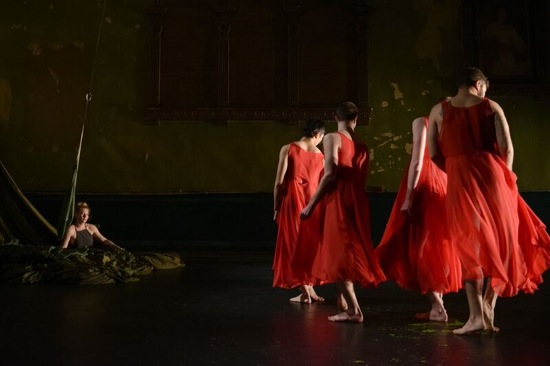
Anneke Hansen’s 2 hymn vb. (L to R): Hansen, Russell Stuart Lilie, Ezra Goh, Austin Selden, and Chafin Seymour. Photo: Matt Harvey
Hansen and her colleagues have made the performance space collaborate with the world they’re creating. Since 2008, the Irondale Center has inhabited the former Sunday school connected to the Lafayette Avenue Presbyterian Church. It’s a very large second-floor room with a 28-foot-high ceiling, stained-glass windows and balconies all around. Tablets that hang on the balcony-less wall appear in the dimness to bear biblical texts such as the Beatitudes and the Commandments. Between them is a painting of the young Jesus (probably when he confounded the rabbis in the temple).
The green walls with their patches of peeling paint vibrate sympathetically with the environment that Hansen has created with the help of designer Baille Younkman. The light green fabric hanging from wires and snaking along the floor shimmers in Miriam Nilofa Crowe’s magical lighting; it turns out to be an immense parachute—the size that can float a truck from an air transport to the ground. Another hangs from the balcony between the two banks of audience seating.
Bryan Fox did the rigging, but several times during the performance, Hansen stops dancing quite abruptly, climbs a handy stepladder, and connects or disconnects parts of the parachute from the wires that dangle at the edges of the space. She also lifts and drags the fabric—arranging it into nests, waves, walls, and paths for her journey. Nick Yulman’s terrific sound score begins by taking the temperature of the place with quiet rattlings and tickings, sustained tones, soft chords. What could be a gong is struck gently; the rattlings begin to sound like little animal feet in the walls.
As the title of the dance makes clear, Hansen construed “hymn” in its second dictionary meaning as a verb: to praise or celebrate. But she yields to none of the tropes of worship. Frequently her gaze takes in the space with wonder and, perhaps, a little trepidation, but she is in some sense plowing the area with dancing the way a gardener might encourage it to be fertile. She is a wonderful dancer—robust yet soft, sensual but never indulgent, resilient without being airy. She may strike a position and hold it for a few seconds. Such moves are neither decorative nor simple; one involves holding herself flat out in a prone position but ten or so inches off the floor, balanced on one forearm and the tucked-under toes of one foot. She travels smoothly between standing and lying—folding herself to the floor with amazing celerity and ease, rolling, rising, twisting, sinking again. As the solo progresses, she becomes more expansive, wheeling a leg through the air, spinning, adding a spring to her steps. But what is most satisfying about her dancing is the way she subtly shifts the quality, the timing, and the emphasis within what a lesser dancer might present as a simple continuum. She lets you see her thinking, and then see her revising that thinking.
All through this, the shrouded figure continues to travel at her glacial pace across the room, and suddenly, if you turn your head to the right, you can see the four men gradually assembling into a cluster very close to the side edge of the spectators. Ezra Goh, Russell Stuart Lilie, Austin Selden, and Chafin Seymour wear full skirted, sleeveless dresses of a lightweight red fabric. Perhaps Hansen has conjured them up.
The men’s journey into the rest of the space is a slow one. Facing in different directions and changing those facings, they present themselves as a unit, but it’s a few minutes before they assume the same focus. Hansen is still dancing intermittently, but she’s also rearranging the heavy load of fabric, wearing herself out. When she has arranged it into a nest, she sits on it and rests, staring toward us, not seeing the men as they move to the rear wall and suddenly turn and slide down it to sit (all but Selden, who, pressed against the wall, stretches his long limbs in different ways).
When the four men rise to dance, the audience gets another surprise. As they swirl across the space and take little, uneven jumps that echo Hansen’s earlier ones, you notice—as if by accident—that they are naked under their gowns. Not cross-dressers exactly; more like archangels.
Kneeling pressed against the wall, they disappear when Hansen embarks on the most astonishing part of 2hymn vb. In a temporary glare, she begins her most complex re-rigging yet, and by the time she has finished, she is standing in a pool of fabric, tying it around her waist via a hole at its center, so that she is surrounded by an immense, anchored skirt. Now bare from the waist up, she rushes from one side to the other of this habitat, and the billowing fabric creates caverns for her to plunge into, waves that curl against her. For minutes on end, I saw her as Venus Anadyomene, although if she were going to rise from the sea, this was a fantastically difficult birth.
During a quiet moment in 2hymn vb, Hansen extends one foot over the low front wall of fabric, as if planning on stepping out; she decides against it. Then she’s back inside the silky tumult, now holding parts of it in her hands and lashing and whipping it and twisting into it. The lighting makes the ocean of green shimmer, warms her flesh. Her breathing becomes ragged. Suddenly she frees herself, climbs the ladder to unhitch something, and exits unceremoniously via a nearby door, leaving He— almost at the end of her long, dark covering—still crawling, the music swelling and dying, the lights going out.

